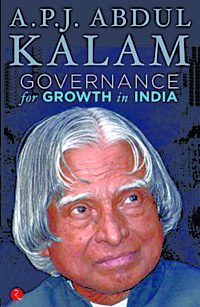RELEVANCE: 4/5
WRITING STYLE: 5/5
ENTERTAINMENT QUOTIENT: 4/5
“As India chooses its 16th Lok Sabha…..” and so goes on the introduction of the book.
First off, before I go any further into the discussion, I must add that the author Dr Kalam, who is no doubt one of the most respected and influential Indian President of our time(a post which has been turned into a mere puppet, post the 24th amendment act in the constitution).
A person, who, by all standards, has set a benchmark for determination and the will to achieve the goal of a developed nation.
Governance for Growth in India is a wonderful memoir of Dr. Kalam’s journey from his days as a graduate of MIT (Madras Institute of Technology) to this date.
The book starts with a recent visit to Ropar, Punjab where he is entrusted with the moral responsibility of answering the question which has eluded the youth of our nation, “Who should we vote for if all the candidates are not worth electing ?”.
And the answer they receive shows the true character of our former president, the one which we have all come to admire.
The book reflects the total life experiences of a man, who has worked with all major aspect of “The largest democracy” in the world, from IAS’s to PM’s, working under brilliant intellectuals of our nation like Dr. Sarabhai.
Abdul Kalam shares his knowledge and collective experiences in hopes of leading the Indian youth towards a more educated and leadership-oriented environment.
If you have read Chetan Bhagat’s “What Young India Wants” and were left wondering what and how to achieve those goals and in the process be able to uplift our Motherland, the books puts forward few very interesting concepts which if implemented can really bring about a change.
The best part of the book is the fact, that it is so well organised into chapters and points, and to top it off, such simple use of English. I’d love to see a Hindi version of this book, to increase its reach.
It also talks in exquisite details about various e-governance methods, leadership traits, monitoring policies, responsible citizens, topics which might bore you on a normal day but combine them with a wonderful collection of memories you get the perfect tadka to ponder over.
Few of the references reminded me of Rajiv Gandhi’s famous words on our (as a country) inability to monitor the money allotted for the poor. He said, “if the central government releases one rupee for the poor, only 10 paisa reaches the needy”.
The book puts forward a solution on how to eradicate these cases of poor monitoring of government funds, mainly by increasing transparency in the system via public audits, RTI(Right to information ), the closely-knit structure between different bodies of government etc. so as to increase government answer-ability.
To sum up, Governance for Growth in India shows what a great personality Abdul Kalam is. His prominence and vivid clarity, of which we got a view in “Wings of fire” is pretty clearly evident here as well.
He manages to deliver very clearly a manifesto about what is expected of each and every leader and every citizen of our country to achieve that common goal of “India- A Developed Nation” by 2020, and that too in mere 153 pages.
A final word: A must-read, though at times it might feel like you know the topic pretty well, the author’s insights make it worth a read. Also, it is easy going and a very light read as in comparison to other non-fiction books which talk about India on the pathway to a developed nation.
